Abstract
Food security is a major concern in many countries, including Indonesia. Land productivity has decreased due to shrinking agricultural land, global warming, and land degradation. Precision agriculture (PA) empowers people to use agricultural technology to increase productivity. Therefore, this study aims to examine PA from adopting agricultural machinery. The method used in time series analysis is pooled least squares (PLS). The results show that the transition from conventional methods to using mechanized tools, especially tractors, significantly (at a sig level of 1%) affects rice production in Indonesian rice centers. These results form the basis that Indonesian rice farmers are enthusiastic about various technologies, so the opportunities for PA are significant. However, the gap between PA research in Indonesia and developed countries needs attention, and research collaboration can be a solution. From a practical standpoint, PA integrated with the internet is challenging for Indonesian farmers. Therefore, empowering farmers through various synergy mechanisms is proposed in this study.
1. Introduction
The condition of agricultural land is becoming narrower. It threatens the fulfillment of future food needs, adding to the threat of population growth and increasing pressure on agriculture. In 2022, the world’s population reached more than 8 billion, and is estimated to be 9 billion people by 2037, with a total growth ratio of more than 1%, which causes a large gap in the food supply, even with sufficient nutrition for the population [1]. The issue of hunger is faced by every country. In many developing countries, hunger is more prevalent. The highest hunger rates occur in African countries. Based on the FAO report (2019), food insecurity is higher in Africa, with high water stress levels of over 50% being threatened with food insecurity, America at 32%, Asia at 22%, Oceania at 14%, and Europe/North America at 8% [2]. The efforts must be based on place suitability, participation, diversification, and ecological management to achieve zero hunger. Farmers in developing countries have invested US$153 billion annually in agricultural management [3] to increase production to reduce hunger. According to developments, the available food supply increased from 2017 to 2019, up 7% compared to 2000, with a total of 2870 kcal per person per day [2]. Food supply is closely related to agricultural production. Therefore, to increase agricultural output, the right strategy must be used.
The increase in agricultural results in traditional methods through expanding land and human labor, which has long been doubted. However, over time, the most visible obstacle in agriculture is the limited land used [4]. Changes in the area of agricultural land between 2000 and 2018 decreased by 78 million ha [2]. Another problem is the threat of climate change. Climate change contributes to the decline in agricultural production [3]. Climate change affects rainfall patterns and causes drastic changes in temperature conditions, often leading to many crop failures. Under all climate change, the rice production forecast in Central Java, Indonesia decreased for all three growing seasons in a year, with the second dry season showing the highest reduction of up to 11.77% in the 2050s [5]. Furthermore, it causes the level of hunger among citizens to increase.
Various efforts were undertaken to reduce the threat of hunger. Efforts were made to diversify agriculture, create intensification by fertilizer or intercropping [6], technological innovation, and the development of agricultural mechanizations. However, intensification through high fertilizer found a high concentration of CaCO, so it pollutes water bodies sourced from agriculture [7]. Along with sustainability awareness comes the concept of sustainable intensification [4]. However, this concept must still be widely accepted globally [8]. Conventional agriculture is no longer applicable due to economic, environmental, and limited opportunities. Sustainable intensification is needed to meet the world’s food needs in the next 30 years [9]. Because of this, a sustainable farming system has been developed in the era of globalization. The development of increasingly advanced science and technology encourages the formation of an approach using technology. Precision agriculture (PA) was introduced in 2002 [10]. This concept is an implementation of natural resource management towards sustainable agriculture.
PA is generally widely applied in developed countries and still needs to be improved, and a process for adopting it needs to be developed in developing countries. The low utilization of PA technology is due to inadequate counseling [11]. In contrast, PA has many benefits in optimizing agricultural production. PA technology can be used to predict pests, reducing losses caused by pests [12]; calculation of the economic benefits of saving on pesticide use shows that pesticides will be reduced by 10–35% when 30% of farms adopt precision farming (PF) technology [13]. The risk of hunger in Africa is expected to be reduced to 5–10% by investing in agriculture technology [3]. The application of PA in Africa has boosted the contribution of African export products to Europe and pollution reduction [14]. By predicting the maturity level, product quality will be better. The Internet of Things (IoT) and data analysis to predict diseases affecting apple farming in India can be utilized [12]. The prediction aims to minimize damage to agricultural products and increase production. The success of PA needs to be emulated because areas with high environmental vulnerability and social aspects have higher PA benefits [7,15,16]. However, the research also does not emphasize the discussion of empowerment to apply PA in farmers.
Therefore, this study emphasizes community empowerment in adopting of management and adding social aspects towards sustainability. The concept of empowerment, in principle, is the process of strengthening the abilities of those not yet strong and enabling them to become stronger (empowered) to improve their quality of life. In this study, the empowerment process lies in the participation of the community, especially farmers, in PA programs related to implementing agricultural tools and machines integrated with IoT. This study will focus on the discussion of community empowerment in PA by evaluating how they adopt and use machinery and equipment (mechanization). Mechanizations are agricultural tools and machines to support agricultural development, utilizing agricultural tools and machines aimed at making the process of land clearing/processing, harvesting, and post-harvesting run more optimally than conventional farming. Mechanization became the forerunner to the implementation of PA, in which the PA technology is an advanced version using a digital system to become more accurate in its operation. PA not only achieves the goal of optimal farming but is also effective and efficient, as well as achieves the goal of conservation of the agricultural environment. Therefore, assessing the role of machine tools in optimizing agricultural production is important to promote PA more broadly throughout Indonesia, where small-scale farmers dominate. Only a little research has discussed the time series of agricultural development from conventional farming to the role of machines used in agricultural production towards PA in Indonesia, especially rice as the main food commodity in Indonesia. Previous research only descriptively details how the role of using machinery in supporting rice farming is, but has yet to show quantitative empirical evidence.
Meanwhile, a synthesis of studies on PA in Indonesia should be researched further. The research aims to emphasize the stages of PA, from conventional agriculture to mechanization, by adopting agricultural machinery to its journey towards IoT technology for PA. In disseminating PA in Indonesia, research provides an overview of the importance of community empowerment to participate in the adoption of PA. This study took place in Indonesia by analyzing five provinces: West Java, Central Java, East Java, North Sumatra, and South Sulawesi. Judging from the goals to be achieved, the subject of rice farming is vital to choose from. The appropriate reason is the threat of hunger, requiring a PA approach for food security. Indonesia is an agricultural country with a large agricultural production of rice, especially rice as a staple food. Rice productivity increased between 2014 and 2018 [17]. However, moving forward to PA, the farmer’s challenge in Indonesia is to have the ability of agricultural tools and machinery by IoT [16]. They also need help absorbing knowledge to increase crop yields. Moreover, they need help learning and understanding technology [18]. Therefore, the strategy for socializing PA to rice farmers and synergistic empowerment will be discussed in this study. Community empowerment is appropriate as a form of community participation in the country’s development. In this paper, the author wants to examine the PA of adopting agricultural machinery within a decade (2007–2021). If it is associated with the theory of planned behavior, the individual’s willingness to adopt a method is driven by the perceived benefits. So, the debate center of this issue is about social science associated with agricultural methods from the past to the present, the history of PA in Indonesia, the knowledge gap with developed countries, and community empowerment strategies as an effort to disseminate PA. The results of this study are expected to indicate the importance of PA and can encourage the spread of adoption.
2. Literature Review
Development of PA Research in Worldwide Compare with Indonesia
PA has experienced rapid development globally, so developed countries are increasing their efforts in conducting PA research. The association method to evaluate the co-country analysis of PA research worldwide was clustered. In Figure 1, there are 59 countries with the criteria of having at least four research articles on PA. The circle shows the number of documents in the country, while the line shows collaboration links between countries on PA research. The United States has mostly researched PA and collaborated with various countries with a total of 44 links with a total of 310 documents.
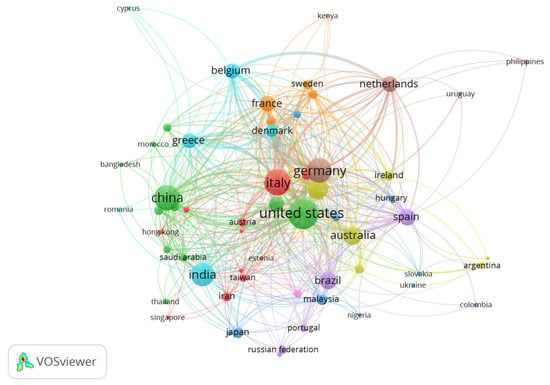
Figure 1.
PA worldwide research with high citations from 2007 to early 2023. The colors indicate the presence of different clusters marked with color circles indicating the number of occurrences of the keyword; the lines connecting each keyword indicate their relationship.
Furthermore, countries intensely conducting PA research are Italy, with 24 links and 233 documents; Germany, with 37 links and 209 documents; and China, with 29 links and 233 documents. At the same time, the analysis in Indonesia uses a minimum of three research articles (due to limited data). Indonesia has the strongest PA research collaboration links with Australia, the Philippines, and Japan, with a total strength of 12 collaborative links to produce 57 PA research documents (Figure 2).

Figure 2.
PA research in Indonesia until early February 2023. The colors indicate the presence of different clusters marked with color circles indicating the number of occurrences of the keyword; the lines connecting each keyword indicate their relationship.
The implementation of PA has spread across Europe and America. In the UK and Ireland, the adoption of PA still needs to grow [15]. Technology implementation is spread unevenly and compared to the US and Australia, implementation in the EU is lower [4]. Katalin et al. [13] predict pesticide use savings on PA adoption in the EU saving on fertilizers used. A study conducted in Ontario, Canada regarding the profit mapping method in agricultural management, but was less than optimal, resulted in economic losses [9]. Figure 1 and Figure 2 indicate that there is a research gap in Indonesia. This analysis is intended to evaluate Indonesia’s future PA research by increasing collaboration with developed countries that are successful in PA applications so that Indonesia can develop its agriculture properly and ensure food security.
Furthermore, the scope of PA research conducted in Indonesia needs to be understood. PA analysis in Indonesia uses a co-occurrence analysis unit with a minimum of three occurrences of the retained keywords so that it becomes 48 keywords. Based on Figure 3, PA in Indonesia has a strong relationship with the term PF, shown in the number of lines that connect PF and PA. The terms PF and PA in Indonesia fall into the category of the same goal. Furthermore, time series analysis shows that PA research began to be massive in 2017 and above, and most research was in 2019–2020.
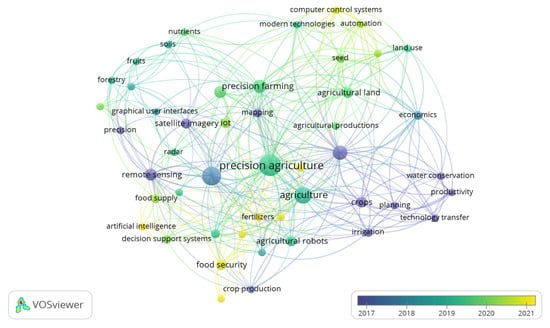
Figure 3.
Time series of PA research in Indonesia. The colors indicate the presence of different clusters marked with color circles indicating the number of occurrences of the year; the lines connecting each keyword indicate their relationship.
The method of PA is carried out by utilizing technology, which is always developing, making agricultural activities more effective. Based on Figure 3, Indonesian PA research has begun to lead to the complexity of using technology and IoT integration to increase agricultural production and the economy. PA is a complex process involving various data from various sources, including agricultural science, soil science, chemistry, and environmental science, to determine priorities [7]. PA is an interdisciplinary approach, collaborating between agronomy, sociology, ecology, and economics [19]. The PA approach can be carried out from agricultural preparation to harvesting. The preparation stage involves selecting an area suitable for environmental and agricultural conditions more precisely because it can accurately detect the precise area that had trouble or is different in most conditions. Furthermore, data processing is carried out to explore the agricultural potential and obtain appropriate decision-making recommendations [20]. The implementation of PA forms a cycle starting from observation, evaluation, data interpretation, and management [21].
In the agricultural sector, sustainable development is needed for food availability; it enables the increase in productivity to achieve food security, both for short-term fulfillment and a long-term fulfillment. The PA approach offers alternative options in environmental management, with environmental conditions experiencing various pressures [22], including both climate change and population growth. This concept offers economic and social benefits for farmers and the community. There have been many studies discussing the importance of PA and the impact. Some of the advantages of implementing PA are not only about cultivation and processing resource problems but also about the availability of data that have been collected [20]. Accurate information about soil conditions, humidity, temperature, and nutrients can be used for scientific development.
Based on this research, large farmers have dominated the adoption of PA when it is compared to small farmers, and it is more popularly used in developed countries than in developing countries (Figure 1). The dominance of implementation is identical to the existence of a high level of education, skills, capital, and motivation [19,23]. It is not infrequent that the high required capital becomes an obstacle to adoption in developing countries, especially for small farmers. The uneven distribution of information is also accused of being a barrier to adoption. Some have mentioned the less-than-optimal benefits of adopting PA for small farmers. However, Barnes et al. [22] refuse this assertion; small farms adopting agriculture offer maximum social return benefits. PA has the potential to be adopted by both large and small farmers [19]. The adoption of PA for large farmers is more for the use of new technologies, while for small-scale agriculture, it is more labor intensive. A large percentage of small farmers has the potential to achieve higher food security.
3. Materials and Methods
The type of research used in this study was mixed-methods research. Observations were carried out in various ways, such as surveys, questionnaires, interviews, and secondary data. However, most importantly, observations must be recorded properly to be analyzed further. This study aims to obtain a description or description of community empowerment in PA by analyzing agricultural machinery. Data and information regarding the level of use of machinery used in this study were obtained from the Center for Socio-Economic Studies of Agricultural Policy Indonesia and then analyzed descriptively.
Secondary data were gathered from the Scopus database through articles emphasizing theme-related research. The data were processed using VOSViewer 1.6.18 software using a clustering procedure. The keywords Scopus selected in the literature for the Indonesia search were (1) PF Indonesia, and (2) PA Indonesia, and then entered into the merging and sorting process using Microsoft Excel 2010 software; the results obtained 69 research articles. Obtaining secondary data for PA worldwide involved entering keywords in Scopus, including PF paddy fields, refining and screening with data in 2007–2023 for 2000 articles with high citation filters on the search engine, and resulting in the highest citation (on February 2023) being the mapping of cropland by Landsat imagery [24].
The panel data used were National Farmers Panel data (PATANAS) for 2007–2018 for the five main rice-producing provinces at that time, namely North Sumatra, West Java, Central Java, East Java, and South Sulawesi. The number of samples used was as many as 252 households spread over five areas of rice production centers in Indonesia. The variables analyzed in this study were control of agricultural assets in rice farming, such as ownership of pre-harvest and post-harvest agricultural equipment and machinery, including tractors, hand tractors, threshers, transplanters, and mini combine harvesters. PATANAS is the household data of farmers from the census and survey of the Ministry of Agriculture Indonesia. PATANAS covers rural research in various provinces in Indonesia. Hence, the secondary data obtained by PATANAS have comprehensive coverage and are quite accurate as material for writing scientific papers. Operationally, PATANAS can be used, among other things, to measure agricultural production parameters, measure the effectiveness of government policies to increase information quickly, and adopt future agricultural production systems for data agriculture mechanization in 2018–2021 using data from the Directorate General of Agricultural Infrastructure and Facilities, Ministry of Agriculture Indonesia [25].
The data from surveys, questionnaires, and interviews with analysis techniques were undertaken using simple regression to determine the correlation between the variable value of rice production and the variable use of agricultural tools and machines. The data analysis technique was undertaken using correlation between the variable value of rice production and the variable use of agricultural tools and machines. The formula used in the analysis of the panel data was pooled least square (PLS). The empirical model used in this study is as defined in Equation (1).
where
Qit = a + b1HTrit + b2Thrit + b3W it + b4Trit + e
Qit = value of rice production (IDR)
HTrit = hand tractor
WPit = water pump
Trit = tractor
e = error term
4. Results and Discussion
4.1. Analysis of Conventional Farming to Machinery (Mechanization)
Indonesia, in conventional farming, has been applying plows with livestock for a long time. Mechanization has begun to introduce technology to the farmer to increase agricultural productivity and minimize the required inputs. For example, the mechanization using tractors and rice threshing machines has replaced the less effective use of human or animal labor in cultivating land, requiring more labor, animals, and the expenditure of wages. Technology is used to maximize agricultural yields, and tractors make it easier to cultivate rice fields at the land preparation stage; farmers save labor wages by saving input costs and are more efficient than conventional processing. Therefore, mechanization through tools and machinery includes the effective support for the farmers in their ability to achieve common prosperity and food self-sufficiency.
Mechanization positively impacts farmers because it makes their work easier than conventional farming, which relies entirely on labor. In the development of science and technology, mechanization is developing very well and fast, combined with the Internet of Things (IoT), which is more accurate and precise. Therefore mechanization is moving towards precision agriculture (PA) (Figure 4). The PA must be explored to determine the right strategy for disseminating information and technology to farmers. There are many excellent studies on PA but are limited to research because the applied applications to farmers encounter many obstacles. This paper will provide a strategic perspective on PA application through empowering farmers and the key to PA success. Dealing with the results of the analysis that has been undertaken, the researchers analyzed the agricultural mechanization as the reason for moving forward in PA.
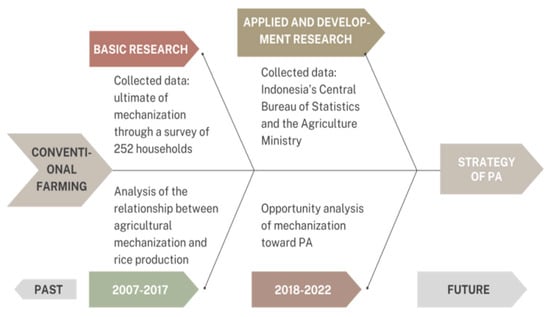
Figure 4.
Fishbone analysis from conventional farming to PA based on this research.
Agricultural development has been directed to increase business productivity through agricultural science and technology from conventional farming, supported by improving the quality of human resources [26]. The beginning of developing technology creates agricultural tools and machines for ease of cultivation and harvesting to evaluate conventional farming, which has many weaknesses. For example, tractors and harvesting machines have positively affected agricultural productivity [27], supporting farmers’ welfare. The use of resources can be minimized by reducing production costs with optimal results. We analyzed agricultural tools and machinery development in Indonesia from 2007 to 2017 in five rice-producing provinces. After that, the adoption of the concept of PA took place and began to develop rapidly in world research by applying technology to facilitate the mechanization of agricultural activities but with more precision because it combines several technologies such as IoT-based platforms, geographic information systems, and agricultural machine tools [28]. The PA concept in many articles is called precision farming (PF). However, the use of technology is based on the ability of farmers in each region with the environmental and socioeconomic conditions of the farmers.
4.2. The Use of Agricultural Tools and Machinery (Mechanization) in Paddy Rice
Figure 5 shows the trend in using agricultural tools and machinery based on the five main rice-producing regions in 2007. All regions show the use of small tractors (hand tractor) and threshing machines except for West Java. The use of large tractors is only found in West Java, with a percentage of approximately 30%. The largest use of small tractors is in North Sumatra, with a proportion of 90%, while for Central Java and East Java, the proportion is the same with the use of threshing machines, which is 50%. Furthermore, the smallest thresher machine is North Sumatra, with a percentage of approximately 10%.
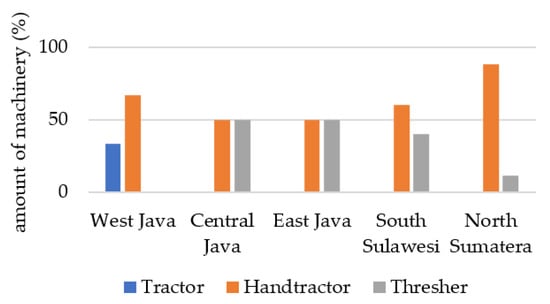
Figure 5.
The usage of agricultural machinery in 2007.
Figure 6 illustrates the distribution of ownership for agricultural tools and machinery in 2007 in Indonesia’s rice field agro-ecosystem in five main areas. The dominant agricultural tools and machines used are small tractors and threshing machines. North Sumatra has the highest use and ownership of small tractors, while other areas have a balanced proportion of tractors and threshing machines. West Java is the only area with large tractors in the five regions. However, in 2008, the data obtained were from small tractor ownership in Central Java and agricultural machinery in North Sulawesi with the secondary crop agro-ecosystem.

Figure 6.
The ownership of agricultural machinery (2007–2008).
The use of agricultural tools and machinery in 2010 is shown in Figure 7. Based on the graph, two regions maximize the use of small tractors compared to other tools and machines, namely West Java and North Sumatra, with a percentage of 100%. Meanwhile, other regions show a balanced utilization of agricultural machineries, such as the East Java region, with the proportion of each tool and agricultural machine being 33%. The South Sulawesi region does not use large tractors, so the proportions of other tools and machines are around 40% and 50%, respectively, for small tractors and threshing machines. The use of agricultural tools and machinery in rice farming was dominated by small tractors in 2010, while in 2011, threshing machines tended to be used more with high ownership than other tools and machines (Figure 8). Large tractors are mostly found in Java, especially Central Java and East Java.
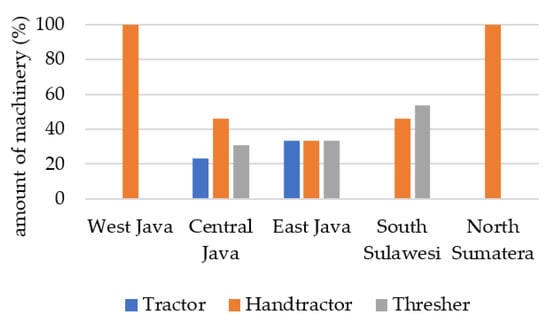
Figure 7.
The usage of agricultural machinery in 2010.
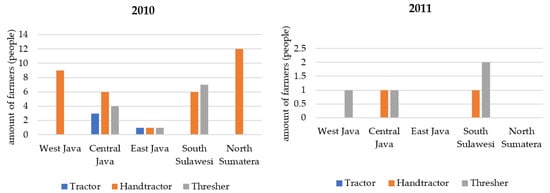
Figure 8.
The ownership of agricultural machinery (2010–2011).
In 2016 (Figure 9), agricultural tool and machinery use showed a significant trend change where the use of large tractors in the five areas was nil. Meanwhile, the area where the maximum proportion of large tractor use reached 100% was North Sumatra, while the smallest proportion of small tractor use was Central Java, with a percentage of 44%. However, on the other hand, Central Java and West Java showed fairly high use of threshing machines, with a percentage of approximately 55%. In West Java, the use of thresher machines from 2007 and 2010 was not found, but in 2016, there was a 50% use of thresher machines. These data indicate that in 2007 and 2010, the adoption of thresher technology was still low among farmers. Knowledge about the benefits of threshing still needs to be improved.
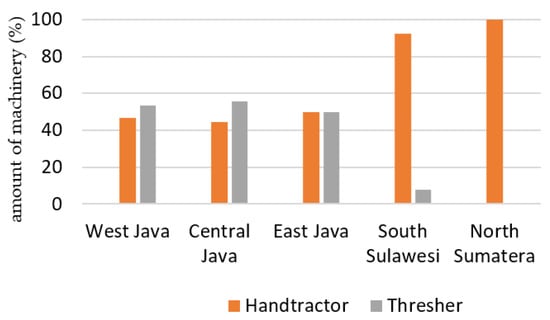
Figure 9.
The usage of agricultural machinery in 2016.
In 2016, there was the adoption of technology, proving that farmers have begun to realize the benefits of technology in increasing agricultural productivity. Threshing machines are quite effective, forming a better, cleaner quality of rice. The use of technology can shorten the time in harvesting [29]. Figure 10 shows the ownership of tools and machines in 2016 and 2017, an increase in the type and quantity of agricultural tools and machines used; in 2016 all regions tended to use small tractors and threshing machines, while in 2017, there were more power sprayers used in the region, especially in West Java, Central Java, East Java, and South Sulawesi.
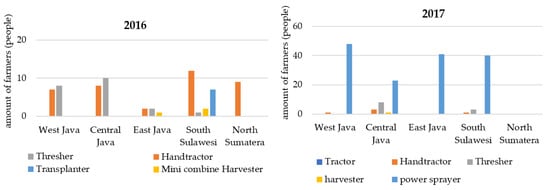
Figure 10.
The ownership of agricultural machinery (2016–2017).
The transfer of technology supports the increase in the productivity of farmers. However, technology adoption of technology is based on awareness of benefits. The greater the benefits of technology, the more it encourages farmers to own it with the support of their economic power. Adopters significantly influence assets that can ensure food security [30]. The ownership of agricultural machinery will increase the wealth of farmers’ assets as the additional agricultural input capital to maximize yields and increase welfare. In 2017, in almost five provinces, there was an increase in ownership of pesticide-spraying machines. This proprietary machine implies farmers rely heavily on pesticide-spraying activities to facilitate farming. However, what happened was only in North Sumatra, where the ownership of the sprayer was not found. Some need more funds to buy tools, with renting considered more effective than buying. Farmers allocate available funds for other activities. This year, the ownership of tractors and threshing and harvesting machines also decreased. The popularity of pesticide sprayers must be monitored. The excessive use of sprayers can cause immunity to pests, as well as kill predatory animals. So instead of increasing productivity, there is a decrease in productivity. Yamamoto, Shigetomi, Ishimura, and Hattori [31] found that agricultural productivity in Indonesia decreased by 45% between 2001 and 2014 because of pests and losses reached US$2.63 billion in 2014. From this experience, farmers have realized the importance of pest management; using sprayers to distribute pesticides is very helpful for the community.
Technology development in facilitating agricultural activities has changed from 2007 to 2017. The use of tractors has shifted from the existence of large tractors to the use of small tractors. As of 2007, large tractors are still in use in some areas. It needs to be seen in the following year as an illustration of the community’s response to mechanization. This use indicates a change in the scale of agriculture, where household farms have replaced large farms in the 2018–2021 period (Figure 11 and Figure 12). Large tractors have greater mechanical power and are capable of cultivating larger agricultural land. Large tractors are considered ineffective when agriculture in Indonesia has undergone a size change to become a small-scale farm. In 2017, in every Indonesian region in Indonesia, large tractors were almost nonexistent. They were replaced with small tractors because small-scale farming uses small tractors that use simpler machines and lower costs, either from fuel use or maintenance (Figure 8). Figure 9 shows the highest mechanization in South Sulawesi in 2018 for large tractors compared to other provinces. It is interesting because it is in line with Indonesia’s vision as a food source, so the food estate program is focused on the clearing marginal land that requires many tractors. The substitutability of peatland as a food estate is needed to prepare canals, irrigation construction, and rice field designs [32].
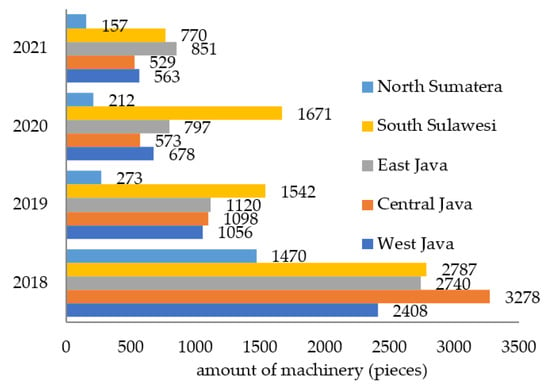
Figure 11.
Agriculture mechanization of hand tractor (2018–2021).
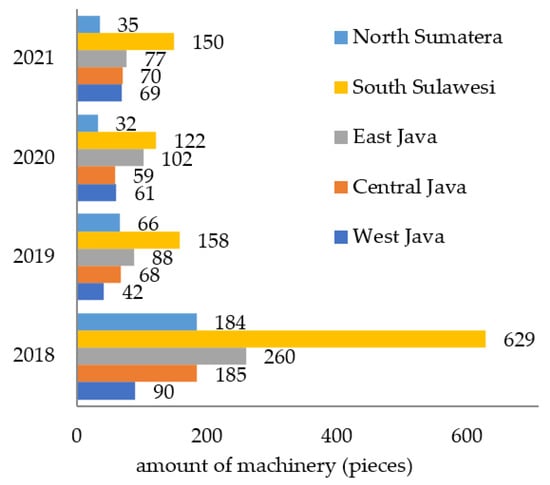
Figure 12.
Agriculture mechanization of tractor (2018–2021).
The development of water pumps for irrigation is increasing yearly (Figure 13) because water is crucial for food crops. Coupled with extreme climate change, it can cause prolonged drought at this time. Therefore, the government’s attention to irrigation mechanization through water pump subsidies is very helpful for farmers in overcoming crop failure due to drought and ensuring water availability. Overall, in 2018–2019, the mechanization of the hand tractor (small tractor), tractor (large tractor), and water pump, and the amount allocated to the five rice center areas in Indonesia fluctuated because it was adjusted to the needs of farmers or groups farming and the area of land available.
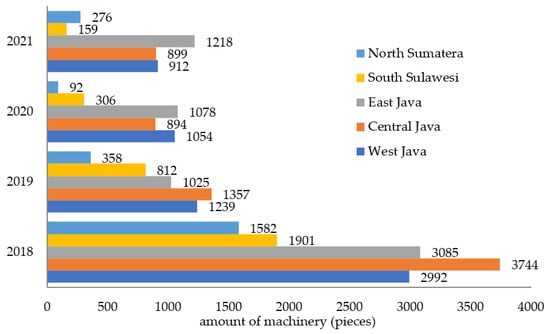
Figure 13.
Agriculture mechanization of water pump (2018–2021).
Large tractors may be less effective on small farms and are more efficiently used on collective farms. Large tractors were abandoned in practice because they were too expensive to use on small farms. In essence, the use of tractor scales is adjusted to the size of the farm to make it more efficient [33]. The use of large tractors is affected by costs also because of more fuel consumption. Although large tractors are capable of cultivating larger land, when the area of land owned is not large, farmers will switch to smaller tractors. In addition, ownership of the machine also requires backup costs to carry out maintenance [34]. Ownership of agricultural machines implies an increase in the welfare of farmers who previously did not own agricultural machines. Technology ownership provides opportunities for increased return-to-scale production. Farmers with agricultural machines obtain a higher return-to-scale result than those who rent machines. Machine rental prices are not elastic to the price of goods [35]. As the number of household farms increases compared to collective farms, the number of users of small tractors increases. This leads to a decrease in the number of large tractors [33].
Data show that ownership and adoption of agricultural machinery from power sprayers and harvesters still need to be popular. The utilization of technology is more about adopting tractors and threshing machines. Ownership of other machines is still very low, even though ownership of agricultural technology is associated with asset wealth. The lack of technology ownership is based on allocating farmers’ costs for agricultural equipment. Household size, land area, and land ownership affect equipment ownership [36]. More funds are needed for the ownership of agricultural technology. Generally, farmers rent the machinery, but the rental system is less than optimal for improving farmer welfare, only to support increased productivity. Individual and group rentals also have differences; greater profits are obtained if farmers rent individually.
Moreover, there is an import policy from the government, which can reduce the price of rice for farmers. Return-to-scale production is part of the economic goal, where economic factors encourage machine ownership to maximize profits. The use of technology needs to be encouraged continuously. Given the importance of technology in supporting agricultural productivity, it is necessary to support farmers through technology transfer. The government can make many efforts through credit facilitation policies or technical assistance. Agricultural extension workers as facilitators can facilitate agricultural activities and provide maximum agricultural output for the welfare of farmers, improving the country’s economy and food security.
4.3. The Impact of Agricultural Mechanization in Main Rice Producing Area
The use of agricultural machines is the forerunner of the implementation of PA. With agricultural machines, rice farmers can farm with efficient inputs and techniques so that there is no waste of resources. Suppose the level of technology is increased by digitizing agricultural machines through IoT. In this case, farmers can cultivate the land, plant, care for, and harvest crops precisely based on the information received. This information is obtained from the real evidence of agricultural mechanization showing that farmers are open and want technological progress. The estimated effect of technology on agricultural machinery is presented in Table 1.

Table 1.
Estimation result of the relationship between agricultural machinery and production.
The agricultural machinery used affects rice production in the study area differently. Hand tractors positively influence rice production only in North Sumatra and Central Java at a significance level of 1%. The insignificance of hand tractors in other provinces is due to the limited use of hand tractors in these provinces. Meanwhile, using a thresher increased rice production in all provinces with significantly different levels (99% for North Sumatra and South Sulawesi, 95% for the other three provinces). The water pump positively affects rice production only in North Sumatra and East Java at a significance level of 1%. At the same time, using tractors is very influential in increasing rice production in all provinces at a significance level of 1%.
Using agricultural machinery can increase labor efficiency and productivity and increase rice production. It is also in line with the Ministry of Agriculture Indonesia [37], which also prioritizes the development of agricultural mechanization to support increased production in achieving food security. Although the rice policy had many shortcomings, the government has tried to develop agricultural mechanization, especially in Indonesia’s main rice-producing areas. The results of this study are expected to be a lesson learned for the government to always to pay attention to the development of agricultural mechanization for moving PA forward.
4.4. The Implementation PA in Main Rice Producing Area
The increase in the use of tractors indicates a labor shortage in cultivating the land. The high flow of urbanization of citizens evidences this. Urbanization in Indonesia has increased; in 2011, the population in cities was the same as in rural areas. By 2020, urbanization had increased to more than 56% [38]. Meanwhile, the population’s interest in agriculture has decreased due to urbanization and jobs in cities. Farming is not an attractive economic activity for the current generation, as reflected in the declining trend of the economically active population in agriculture [39]. On the other hand, population growth pressure has become a major threat to ensuring self-sufficiency in rice (Figure 14). Decreases in agricultural land in the central rice-producing region raises concerns about the country’s food security (Figure 15). Areas are optimal for PA, and the data obtained show that these are areas that benefit farmers in agriculture [9]. However, many unproductive lands still need to be planted, thus requiring large costs and low profits for farmers. Alexandridis et al. [7] argue that areas that obtain optimal benefits from applying PA are areas located in environmentally sensitive places, such as drought areas. Areas that lack resources, such as dry areas, are suitable for the application of PA [40]. PA technology is used to provide opportunities to assess water stress.
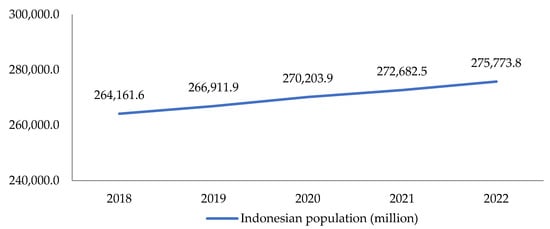
Figure 14.
Indonesian population (2018–2022).
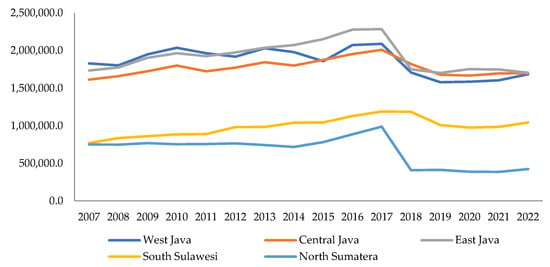
Figure 15.
Paddy farming area in Indonesia.
Conventional farming can no longer meet food needs with an increased population [16]. The push for sustainable agriculture is becoming popular. Sustainable agriculture includes several components: socioeconomic, environmental, and management. Sustainable intensification includes the effective use of water, fertilizers, and pesticides. Research conducted by Jat et al. [41] discusses sustainable intensification that has increased agricultural yield efficiency. Previously, there had been exploitation of water resources in agriculture, which increased production costs so that profits were minimal. The current development has enabled the discovery of new technologies to increase productivity through PA for optimal management.
Agriculture in paddy farming requires resources such as land, water, and others as production capital. Using fertilizers, pesticides, and irrigation water in agriculture contributes greatly to the degradation. Agriculture is assumed to be the largest producer of greenhouse gas occurring by 16% [2]. Threatening the sustainability of the environment by using pesticides to repel pests without rules can cause pests to become resistant [42,43]. Excessive application impacts the remaining phosphorus concentration in the soil and can become eutrophic in water bodies when carried off by runoff [15]. Many argue that PA is an alternative key to meeting future food needs to maintain agricultural sustainability. The adoption of PA has the potential to achieve climate-smart agriculture by utilizing nitrogen fertilizer implementation [19]. The provision of nutrients to plants must follow the ratio and be based on soil conditions. The fertilization requirement is determined by the type of soil, the availability of nutrients, environmental conditions, and what plants will be planted [44]. We need to maintain soil quality for agricultural productivity and the environmental services it provides. Moreover, the use of pesticides is developing into a new threat to the environment [45].
Using proper technology can help Indonesia achieve food security [46]. Research about PA on paddy fields implemented in Indonesia is still limited but the technology of PA is always developing. Remote sensing technology was implemented to cover a large paddy field in Sukabumi, Indonesia, and the findings from both Sentinel 2 and UAV may be used to demonstrate paddy distribution depending on different growth phases [47]. UAVs on paddy fields in Cianjur, Indonesia, can give continuous recordings and objective assessments with less time and work [48]. Some of the UAV images and the C-band SAR gamma-naught thresholds are achievable by utilizing remotely sensed data to identify flood areas in Bandung, Indonesia, especially as a pest observer on paddy [49]. Estimating the amount of water required at each growth stage of rice also can be monitored in near real time in West Java, Indonesia [50]. However, there still needs to be more research that proves actual scientific productivity results that PA in rice cultivation in Indonesia can increase yields. Research findings in Cimahi, Indonesia clearly show that PA using real-time water supply monitoring can increase rice yields from two to three annually [51]. These findings indicate that the relationship between PA and the increase in rice in Indonesia has found a small amount of light in the research that has been conducted, but PA can be applied in Indonesia. The transformation of PA technology innovation that continues to develop opens up great opportunities for Indonesian rice farming.
Technologies such as artificial intelligence (AI) and the internet provide solutions to face the challenges of globalization. PF is based on the IoT [12]. IoT can link sensor devices to collect data. The utilization of technology aims to obtain the right environmental condition data to be analyzed for decision making (Figure 16). IoT will find the possibility of bad things happening to plants, such as pest infection [52]. It will help farmers to produce more rice production. IoT for farmers can reduce fertilizer use by up to 70%, depending on the type of commodity and land conditions [53]. In addition, farmers can also know the weather conditions so that fertilization is optimal [54].
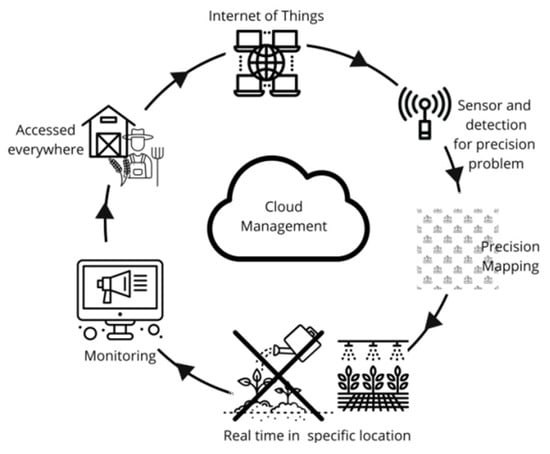
Figure 16.
PA systems.
The initial process carried out by farmers if they want to implement PA is to acquire data [55]. Acquiring these data is a process carried out to retrieve data regarding the level of soil fertility, irrigation conditions, and weather around the location of paddy fields [56]. The data that have been obtained from the location then need to be accessed. The resulting data will be used as guidelines by farmers to make decisions in the planting process. There are also some important stages in PA [57]. The first is the positioning system [58]. Positioning is the initial stage in the application of PA, some of the characteristics of which are the use of GNSS (global navigation satellite system) for precise location determination [59]. Examples of its application include tracking the location of agricultural equipment, sensors, and movement. The sensing system uses equipment for activities that follow the objectives [60].
4.5. The Strategy of Dissemination PA to Paddy Farmer
Adopting PA methods and technologies is a challenging job. Farmers have used technology through mechanization, which has greatly proven the work of farmers. Therefore, precision agriculture should be able to be applied by Indonesian farmers, but the adoption of PA has its challenges. PA technology not only has an impact on farmers but also provides benefits to society and better management [10,19]. According to Barnes et al. [22], PA technology is a tool for managing spatial and temporal variables. As before, PA development is influenced by farmers’ attitudes. PA provides recommendations on monitoring results, but the farmers carry out direct management efforts. So, the adoption of PA technology must be accompanied by an increase in sustainable behavior practices by farmers. Providing education to farmers can improve their knowledge and skills of farmers.
Several influencing factors include ease of access to technology [9]. Socioeconomic conditions of farmer households affect the willingness of farmers to participate in increasing productivity. Their desire to increase the impetus in the adoption of PA has been proven in many studies [14]. Kendall et al. [23] explored the factors for the adoption of PA in China, obtaining the results that insight, cost of knowledge, and scale of agriculture are supporting factors. Adnan et al. [44] found that socio-psychological and socioeconomic aspects, education, age, and communication play a role in forming behaviors that lead to the willingness to adopt the technology, as well as assisting farmers in identifying plant types, growth processes, and health conditions [30].
Adoption is influenced by the farmer’s attitude and varies according to the supporting factors. For example, the adoption of PA is not only from the sophistication of technology but also from farmers’ willingness and participation in management. Analyzing the advantages and convenience of technology can help support the adoption of PA. The ability to empower communities regarding the adoption of PA must continue to be improved because it provides many advantages. According to Lovarelli, Bacenetti, and Guarino [61], PA is becoming increasingly important through its support in the decision-making process; the most visible is the change in the view of farmers on management, and how they act in decision making, to keep the economy and environment in mind. The willingness of farmers to adopt is obtained from consideration of technological understanding, perceived performance, management selection, and potential yields [43]. This opinion is supported by Adnan et al. [44], which emphasizes that agricultural sustainability requires the ability of farmers to make decisions.
The decision of Indonesia’s farmers is generally on the cost problem, which causes many small farmers to give up their intentions. The cultural challenge in PA is the in-compatibility of technology from the farmer’s perspective if it is a high price. Kanter et al. [19] suggest that involving local wisdom with PA is important. It is not infrequent that the obstacle in PA is the perception that experience is more appropriate than technology. The stronger belief is in their own perceptions and experiences, giving cynicism toward technology [22]. On the other hand, the issue regarding the area of land for PA is also a consideration. Small farmers contribute about 24% of agricultural land in developing countries, which needs government support. It is estimated that farms under 2 ha produce 28–31% of total agricultural production [62]. Empowering small farms for PA adoption can achieve the Sustainable Development Goals (SDGs), namely, increasing food availability through small farmers. However, some studies doubt implementing PF technology for small farmers [23]. Farmer adoption of precision farming technology requires great help, especially from small farmers.
4.6. Synergistic Empowerment in PA
The lack of knowledge and skills of Indonesian farmers in operating these technological tools and IoT has attracted the attention of researchers to write about PA in Indonesia. Some researchers say there is uncertainty about the profitability of PA products, which discourages adoption by most farmers. Synergistic empowerment in PA analysis can be the answer to the complexity of PA adoption among farmers (Figure 17). According to Morais et al. [8], the uncertainty of the price of agricultural products gives farmers doubts in adopting the technology. Doubts about the high investment return are still being determined [11]. There is a need to increase farmers’ confidence in agriculture extension workers, as it contributes to the increased adoption of PA in farmers. Allahyari, Mohammadzadeh, and Nastis [63] have identified factors that influence attitudes, namely, technical, economic, and accessibility factors, accounting for 55% of changes in attitude adoption. Population demographics have little effect on adoption. However, the younger the age of farmers, the more potential there is for the adoption of PA [4]. The short term is a variable whose short-term benefit relationship is positive. According to Far and Rezaei-Moghaddam [16], the belief of individuals and the impact of social pressure from the community determines whether farmers participate in increasing productivity through PA. The main driving force for adoption is the economic returns that farmers receive [15,22]. The greater PA is adopted in profit-oriented areas, namely large farms, with owned capital supporting the willingness to adopt [15].
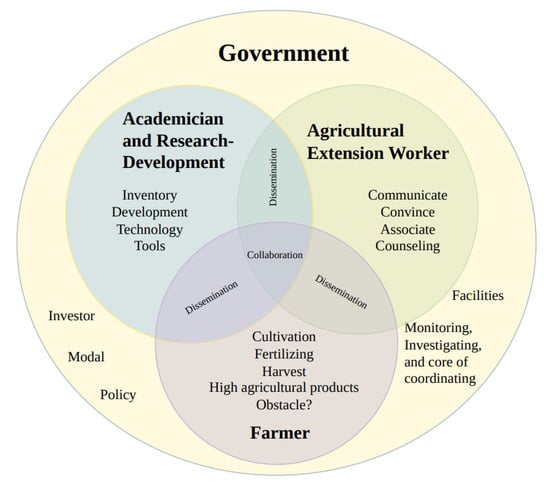
Figure 17.
Synergistic empowerment of farmer.
Capital problems for small farmers can be solved by providing incentives, such as subsidies from the government, to reduce the capital use of technology. Besides the benefit factor, there is the ease of accessibility factor requiring scientific knowledge and ability to implement. Some farmers need more information for innovation [61]. The adoption of PA has a big role in agricultural development and in increasing farmers’ income. Unfortunately, the implementation of PA has not been evenly distributed among large and small farmers. The obstacle that often occurs is that farmers’ intention to participate sometimes shrinks due to capital constraints and can be helped by the government to support food security. The government’s important role as the driving force for PA is to (1) accommodate various parties according to their respective capacities and roles in realizing food security and (2) involve various parties and fully support academic researchers, farmers, and agricultural extension workers. It is necessary to increase knowledge and skills for farmers to balance the use of PA; agricultural extension workers act as assistants to farmers in Indonesia.
Small farms that are homogeneous can combine to implement PA technology together (communally). Maximizing the adoption of PA for both large and small farmers aims to increase yields, reduce environmental impacts, and improve the economy. The top-down method is applied more to link the effectiveness of interaction and farmer acceptance [19]. As the highest authority, the government can regulate and bind the farmers, acacia, research development, and agricultural extension workers through planning and promoting sustainable development by PA. The implementation has been applied to farmers, but stakeholders still need support in its direct implementation [22], so there is no binding obligation on adoption. The involvement of stakeholders in technology diffusion is important for conservation, and social and economic goals [9]. According to Kanter et al. [19], to overcome farmers’ low adoption of precision, the government has contributed to policymaking and institutional changes in adoption.
PA is expected to develop along with paper research and implementation by small- or large-scale farmers. They can compete to increase productivity, thereby creating awareness without sacrificing environmental services so that the environment remains sustainable. The output of this research is expected to assist analysts and policymakers in formulating policies to support the spread of precision adoption. The authors raise a new perspective on PA: the perspective on the benefits of PA. Awareness of the multiple benefits can encourage the adoption by other farmers. Through this research, it is expected to be able to adopt problems that are included in the experience of discussing a complex issue.
5. Conclusions
The issue of food security is a vital problem that occurs in many countries around the world, including Indonesia. The increase in population is higher than the increase in agricultural productivity, therefore, raising fears of hunger. In addition to the decrease in agricultural land, global warming, and land degradation, land productivity has decreased. Conventional agriculture only guarantees optimal production in the current threat conditions. The development of the conventional methods then turned to mechanization through agricultural tools and machines; between 2007–2016, there was a change in the use of tractors. Tool and machinery ownership has also changed; in 2017, tractor ownership decreased dramatically. This has only been found in the provinces of West Java, Central Java, and South Sulawesi, and even then, in a small percentage farms because maintenance costs are not elastic. Overall, the results indicated that agricultural machinery positively affected rice production, especially tractors, which had significance in all provinces included in the study areas (at a sig level of 1%).
Based on mechanization having a positive place in agriculture, the analysis of PA is an important area to study. As a result, PA in Indonesia still needs much research by establishing collaboration with countries that have succeeded in applying PA. However, it is expected that it is not only limited to research, but the implementation by farmers is also important given the complexity of PA integrated with IoT. Not all farmers are familiar with the internet, which is a challenge to determine the right strategy for PA dissemination. The way that is felt to be appropriate in the dissemination can be through community empowerment, which is adjusted with the local wisdom of the community so that farmers are expected to receive knowledge of PA well through this approach. In transferring PA knowledge to farmers, it is necessary to have a synergy between academics and researchers, agricultural extension workers, farmers, and the government must have the same vision to realize Indonesia’s food security.
Author Contributions
Conceptualization, H.H. and E.A.; methodology, H.H., E.A. and A.R.; validation, H.H., E.A., N.I.D.A. and A.R.; formal analysis, H.H.; investigation, H.H. and E.A.; resources, E.A.; data curation, H.H., N.E. and E.A.; writing—original draft preparation, H.H. and N.I.D.A.; writing—review and editing, H.H., E.A., N.I.D.A. and A.R.; visualization, E.A. and N.E.; supervision, T.E.B.S. All authors have read and agreed to the published version of the manuscript.
Funding
This research was funded by Research and Development (Risbang) of Universitas Indonesia, With Hibah Klaster/Grup/Pusat Riset 2021, grant number NKB-653/UN2.RST/HKP.05.00/2021.
Institutional Review Board Statement
Not applicable.
Informed Consent Statement
Not applicable.
Data Availability Statement
Not applicable.
Acknowledgments
This research was conducted with supervision, and technical and substantial assistance from Cluster of Interaction, Community Engagement and Social Environment, School of Environmental Science, Universitas Indonesia (https://social.sil.ui.ac.id, accessed on 20 February 2022). The authors thank Arty Dwi Januari dan Ravita Sari form cluster social SIL who substantially helped in writing this article.
Conflicts of Interest
The authors declare no conflict of interest.
References
- Byerlee, D.; Fanzo, J. The SDG of Zero Hunger 75 years on: Turning Full Circle on Agriculture and Nutrition. Glob. Food Secur. 2019, 21, 52–59. [Google Scholar] [CrossRef]
- FAO. FAO Statistical Yearbook—World Food and Agriculture Series Number 2020; FAO: Rome, Italy, 2020; 366p, ISBN 9789251333945. Available online: https://www.fao.org/3/cb1329en/CB1329EN.pdf (accessed on 27 February 2023).
- Mason-D’Croz, D.; Sulser, T.B.; Wiebe, K.; Rosegrant, M.W.; Lowder, S.K.; Nin-Pratt, A.; Willenbockel, D.; Robinson, S.; Zhu, T.; Cenacchi, N.; et al. Agricultural Investments and Hunger in Africa Modeling Potential Contributions to SDG2—Zero Hunger. World Dev. 2019, 116, 38–53. [Google Scholar] [CrossRef] [PubMed]
- Barnes, A.P.; Soto, I.; Eory, V.; Beck, B.; Balafoutis, A.; Sánchez, B.; Vangeyte, J.; Fountas, S.; van der Wal, T.; Gómez-Barbero, M. Exploring the Adoption of Precision Agricultural Technologies: A Cross Regional Study of EU Farmers. Land Use Policy 2019, 80, 163–174. [Google Scholar] [CrossRef]
- Ansari, A.; Lin, Y.P.; Lur, H.S. Evaluating and Adapting Climate Change Impacts on Rice Production in Indonesia: A Case Study of the Keduang Subwatershed, Central Java. Environments 2021, 8, 117. [Google Scholar] [CrossRef]
- Madembo, C.; Mhlanga, B.; Thierfelder, C. Productivity or Stability? Exploring Maize-Legume Intercropping Strategies for Smallholder Conservation Agriculture Farmers in Zimbabwe. Agric. Syst. 2020, 185, 102921. [Google Scholar] [CrossRef]
- Alexandridis, T.K.; Andrianopoulos, A.; Galanis, G.; Kalopesa, E.; Dimitrakos, A.; Katsogiannos, F.; Zalidis, G. An Integrated Approach to Promote Precision Farming as a Measure Toward Reduced-Input Agriculture in Northern Greece Using a Spatial Decision Support System. Compr. Geogr. Inf. Syst. 2018, 3, 315–352. [Google Scholar] [CrossRef]
- Morais, R.; Silva, N.; Mendes, J.; Adão, T.; Pádua, L.; López-Riquelme, J.A.; Pavón-Pulido, N.; Sousa, J.J.; Peres, E. MySense: A Comprehensive Data Management Environment to Improve Precision Agriculture Practices. Comput. Electron. Agric. 2019, 162, 882–894. [Google Scholar] [CrossRef]
- Capmourteres, V.; Adams, J.; Berg, A.; Fraser, E.; Swanton, C.; Anand, M. Precision Conservation Meets Precision Agriculture: A Case Study from Southern Ontario. Agric. Syst. 2018, 167, 176–185. [Google Scholar] [CrossRef]
- Zhang, N.; Wang, M.; Wang, N. Precision Agriculture—A Worldwide Overview. Comput. Electron. Agric. 2002, 36, 113–132. [Google Scholar] [CrossRef]
- Autio, A.; Johansson, T.; Motaroki, L.; Minoia, P.; Pellikka, P. Constraints for Adopting Climate-Smart Agricultural Practices among Smallholder Farmers in Southeast Kenya. Agric. Syst. 2021, 194, 103284. [Google Scholar] [CrossRef]
- Akhter, R.; Sofi, S.A. Precision Agriculture Using IoT Data Analytics and Machine Learning. J. King Saud Univ. Comput. Inf. Sci. 2022, 34, 5602–5618. [Google Scholar] [CrossRef]
- Katalin, T.-G.; Rahoveanu, T.; Magdalena, M.; István, T. Sustainable New Agricultural Technology—Economic Aspects of Precision Crop Protection. Procedia Econ. Financ. 2014, 8, 729–736. [Google Scholar] [CrossRef]
- Said Mohamed, E.; Belal, A.A.; Kotb Abd-Elmabod, S.; El-Shirbeny, M.A.; Gad, A.; Zahran, M.B. Smart Farming for Improving Agricultural Management. Egypt. J. Remote Sens. Space Sci. 2021, 24, 971–981. [Google Scholar] [CrossRef]
- Higgins, S.; Schellberg, J.; Bailey, J.S. Improving Productivity and Increasing the Efficiency of Soil Nutrient Management on Grassland Farms in the UK and Ireland Using Precision Agriculture Technology. Eur. J. Agron. 2019, 106, 67–74. [Google Scholar] [CrossRef]
- Far, S.T.; Rezaei-Moghaddam, K. Impacts of the Precision Agricultural Technologies in Iran: An Analysis Experts’ Perception & Their Determinants. Inf. Process. Agric. 2018, 5, 173–184. [Google Scholar] [CrossRef]
- Rozaki, Z. COVID-19, Agriculture, and Food Security in Indonesia. Rev. Agric. Sci. 2020, 8, 243–260. [Google Scholar] [CrossRef]
- Aubert, B.A.; Schroeder, A.; Grimaudo, J. IT as Enabler of Sustainable Farming: An Empirical Analysis of Farmers’ Adoption Decision of Precision Agriculture Technology. Decis. Support Syst. 2012, 54, 510–520. [Google Scholar] [CrossRef]
- Kanter, D.R.; Bell, A.R.; McDermid, S.S. Precision Agriculture for Smallholder Nitrogen Management. One Earth 2019, 1, 281–284. [Google Scholar] [CrossRef]
- Su, Y.; Wang, X. Innovation of Agricultural Economic Management in the Process of Constructing Smart Agriculture by Big Data. Sustain. Comput. Inform. Syst. 2021, 31, 100579. [Google Scholar] [CrossRef]
- Domingues, D.; Dowd, C.; Atwell, W. Encyclopedia of Food Grains; Elsevier Inc.: Amsterdam, The Netherlands, 2015; Volume 3–4, ISBN 9780123947864. [Google Scholar]
- Barnes, A.; De Soto, I.; Eory, V.; Beck, B.; Balafoutis, A.; Sánchez, B.; Vangeyte, J.; Fountas, S.; van der Wal, T.; Gómez-Barbero, M. Influencing Factors and Incentives on the Intention to Adopt Precision Agricultural Technologies within Arable Farming Systems. Environ. Sci. Policy 2019, 93, 66–74. [Google Scholar] [CrossRef]
- Kendall, H.; Naughton, P.; Clark, B.; Taylor, J.; Li, Z.; Zhao, C.; Yang, G.; Chen, J.; Frewer, L.J. Precision Agriculture in China: Exploring Awareness, Understanding, Attitudes and Perceptions of Agricultural Experts and End-Users in China. Adv. Anim. Biosci. 2017, 8, 703–707. [Google Scholar] [CrossRef]
- Oliphant, A.J.; Thenkabail, P.S.; Teluguntla, P.; Xiong, J.; Gumma, M.K.; Congalton, R.G.; Yadav, K. Mapping Cropland Extent of Southeast and Northeast Asia Using Multi-Year Time-Series Landsat 30-m Data Using a Random Forest Classifier on the Google Earth Engine Cloud. Int. J. Appl. Earth Obs. Geoinf. 2019, 81, 110–124. [Google Scholar] [CrossRef]
- Directorate General of Agricultural Infrastructure and Facilities, Ministry of Agriculture Indonesia. Available online: https://psp.pertanian.go.id/layanan-publik/buku-statistik-2017-2021 (accessed on 8 February 2023).
- Nasir, S.; Hussein, M.Z.; Zainal, Z.; Yusof, N.A.; Zobir, S.A.M. Electrochemical Energy Storage Potentials of Waste Biomass: Oil Palm Leaf- and Palm Kernel Shell-Derived Activated Carbons. Energies 2018, 11, 3410. [Google Scholar] [CrossRef]
- Hoang, V.N.; Nguyen, T.T.; Wilson, C.; Ho, T.Q.; Khanal, U. Scale and Scope Economies in Small Household Rice Farming in Vietnam. J. Integr. Agric. 2021, 20, 3339–3351. [Google Scholar] [CrossRef]
- Boursianis, A.D.; Papadopoulou, M.S.; Gotsis, A.; Wan, S.; Sarigiannidis, P.; Nikolaidis, S.; Goudos, S.K. Smart Irrigation System for Precision Agriculture—The AREThOU5A IoT Platform. IEEE Sens. J. 2021, 21, 17539–17547. [Google Scholar] [CrossRef]
- Qu, X.; Kojima, D.; Nishihara, Y.; Wu, L.; Ando, M. Can Harvest Outsourcing Services Reduce Field Harvest Losses of Rice in China? J. Integr. Agric. 2021, 20, 1396–1406. [Google Scholar] [CrossRef]
- Arellano, P.; Stratoulias, D. Hyperspectral Vegetation Indices to Detect Hydrocarbon Pollution; Elsevier: Amsterdam, The Netherlands, 2020; ISBN 9780081028940. [Google Scholar]
- Yamamoto, Y.; Shigetomi, Y.; Ishimura, Y.; Hattori, M. Forest Change and Agricultural Productivity: Evidence from Indonesia. World Dev. 2019, 114, 196–207. [Google Scholar] [CrossRef]
- Yeny, I.; Garsetiasih, R.; Suharti, S.; Gunawan, H.; Sawitri, R.; Karlina, E.; Narendra, B.H.; Surati; Ekawati, S.; Djaenudin, D.; et al. Examining the Socio-Economic and Natural Resource Risks of Food Estate Development on Peatlands: A Strategy for Economic Recovery and Natural Resource Sustainability. Sustainability 2022, 14, 3961. [Google Scholar] [CrossRef]
- Chen, S.; Lan, X. Tractor vs. Animal: Rural Reforms and Technology Adoption in China. J. Dev. Econ. 2020, 147, 102536. [Google Scholar] [CrossRef]
- Rohani, A.; Abbaspour-Fard, M.H.; Abdolahpour, S. Prediction of Tractor Repair and Maintenance Costs Using Artificial Neural Network. Expert Syst. Appl. 2011, 38, 8999–9007. [Google Scholar] [CrossRef]
- Takeshima, H.; Houssou, N.; Diao, X. Effects of Tractor Ownership on Returns-to-Scale in Agriculture: Evidence from Maize in Ghana. Food Policy 2018, 77, 33–49. [Google Scholar] [CrossRef]
- Ruzzante, S.; Labarta, R.; Bilton, A. Adoption of Agricultural Technology in the Developing World: A Meta-Analysis of the Empirical Literature. World Dev. 2021, 146, 105599. [Google Scholar] [CrossRef]
- Ministry of Agriculture Indonesia. Available online: https://ppid.pertanian.go.id/doc/1/Draft%20Renstra%202020-2024%20edited%20BAPPENAS%20(Final).pdf (accessed on 27 February 2023).
- The World Bank. Available online: https://data.worldbank.org/indicator/SP.URB.TOTL.IN.ZS?end=2020&locations=ID&most_recent_year_desc=true&start=1960 (accessed on 27 February 2023).
- Panuju, D.R.; Mizuno, K.; Trisasongko, B.H. The Dynamics of Rice Production in Indonesia 1961. J. Saudi Soc. Agric. Sci. 2013, 12, 27–37. [Google Scholar] [CrossRef]
- Zhou, Z.; Majeed, Y.; Diverres Naranjo, G.; Gambacorta, E.M.T. Assessment for Crop Water Stress with Infrared Thermal Imagery in Precision Agriculture: A Review and Future Prospects for Deep Learning Applications. Comput. Electron. Agric. 2021, 182, 106019. [Google Scholar] [CrossRef]
- Jat, R.D.; Jat, H.S.; Nanwal, R.K.; Yadav, A.K.; Bana, A.; Choudhary, K.M.; Kakraliya, S.K.; Sutaliya, J.M.; Sapkota, T.B.; Jat, M.L. Conservation Agriculture and Precision Nutrient Management Practices in Maize-Wheat System: Effects on Crop and Water Productivity and Economic Profitability. Field Crop. Res. 2018, 222, 111–120. [Google Scholar] [CrossRef]
- Mahmud, M.S.A.; Abidin, M.S.Z.; Mohamed, Z.; Rahman, M.K.I.A.; Iida, M. Multi-Objective Path Planner for an Agricultural Mobile Robot in a Virtual Greenhouse Environment. Comput. Electron. Agric. 2019, 157, 488–499. [Google Scholar] [CrossRef]
- Oliver, Y.M.; Robertson, M.J.; Wong, M.T.F. Integrating Farmer Knowledge, Precision Agriculture Tools, and Crop Simulation Modelling to Evaluate Management Options for Poor-Performing Patches in Cropping Fields. Eur. J. Agron. 2010, 32, 40–50. [Google Scholar] [CrossRef]
- Adnan, N.; Nordin, S.M.; Anwar, A. Transition Pathways for Malaysian Paddy Farmers to Sustainable Agricultural Practices: An Integrated Exhibiting Tactics to Adopt Green Fertilizer. Land Use Policy 2020, 90, 104255. [Google Scholar] [CrossRef]
- Zangina, U.; Buyamin, S.; Aman, M.N.; Abidin, M.S.Z.; Mahmud, M.S.A. A Greedy Approach to Improve Pesticide Application for Precision Agriculture Using Model Predictive Control. Comput. Electron. Agric. 2021, 182, 105984. [Google Scholar] [CrossRef]
- Sutardi; Apriyana, Y.; Rejekiningrum, P.; Alifia, A.D.; Ramadhani, F.; Darwis, V.; Setyowati, N.; Setyono, D.E.D.; Gunawan; Malik, A.; et al. The Transformation of Rice Crop Technology in Indonesia: Innovation and Sustainable Food Security. Agronomy 2022, 13, 1. [Google Scholar] [CrossRef]
- Rokhmatuloh; Supriatna; Wibowo, A.; Shidiq, I.P.A. Spatial Analysis of Rice Phenology Using Sentinel 2 and UAV in Parakansalak, Sukabumi District, Indonesia. Int. J. Geomate 2020, 19, 205–210. [Google Scholar] [CrossRef]
- Iwahashi, Y.; Sigit, G.; Utoyo, B.; Lubis, I.; Junaedi, A.; Trisasongko, B.H.; Wijaya, I.M.A.S.; Maki, M.; Hongo, C.; Homma, K. Drought Damage Assessment for Crop Insurance Based on Vegetation Index by Unmanned Aerial Vehicle (UAV) Multispectral Images of Paddy Fields in Indonesia. Agric. 2023, 13, 113. [Google Scholar] [CrossRef]
- Wakabayashi, H.; Motohashi, K.; Kitagami, T.; Tjahjono, B.; Dewayani, S.; Hidayat, D.; Hongo, C. Flooded Area Extraction of Rice Paddy Field in Indonesia Using Sentinel-1 SAR Data. Int. Arch. Photogramm. Remote Sens. Spat. Inf. Sci. ISPRS Arch. 2019, 42, 73–76. [Google Scholar] [CrossRef]
- Hongo, C.; Sigit, G.; Shikata, R.; Tamura, E. Estimation of Water Requirement for Rice Cultivation Using Satellite Data. Int. Geosci. Remote Sens. Symp. 2015, 2015, 4660–4663. [Google Scholar] [CrossRef]
- Safarina, A.B.; Karnisah, I. Kusnandar Two Threshold Smart Irrigation System for Increasing Crop Yield. Indones. J. Geogr. 2023, 55, 172–178. [Google Scholar] [CrossRef]
- Dachyar, M.; Zagloel, T.Y.M.; Saragih, L.R. Knowledge Growth and Development: Internet of Things (IoT) Research, 2006. Heliyon 2019, 5, e02264. [Google Scholar] [CrossRef]
- Channe, H.; Kothari, S.; Kadam, D. Multidisciplinary Model for Smart Agriculture Using Internet-of-Things (IoT), Sensors, Cloud-Computing, Mobile-Computing & Big-Data Analysis. Int. J. Comput. Appl. Technol. 2015, 6, 374–382. [Google Scholar]
- Babcock, B.A. The Effects of Uncertainty on Optimal Nitrogen Applications. Appl. Econ. Perspect. Policy 1992, 14, 271–280. [Google Scholar] [CrossRef]
- Daponte, P.; De Vito, L.; Glielmo, L.; Iannelli, L.; Liuzza, D.; Picariello, F.; Silano, G. A Review on the Use of Drones for Precision Agriculture. IOP Conf. Ser. Earth Environ. Sci. 2019, 275, 012022. [Google Scholar] [CrossRef]
- Kehui, X.; Deqin, X.; Xiwen, L. Smart Water-Saving Irrigation System in Precision Agriculture Based on Wireless Sensor Network. Trans. CSAE 2010, 26, 170–175. [Google Scholar] [CrossRef]
- Cisternas, I.; Velásquez, I.; Caro, A.; Rodríguez, A. Systematic Literature Review of Implementations of Precision Agriculture. Comput. Electron. Agric. 2020, 176, 105626. [Google Scholar] [CrossRef]
- Banu, S. Precision Agriculture: Tomorrow’s Technology for Today’s Farmer. J. Food Process. Technol. 2015, 6, 474. [Google Scholar] [CrossRef]
- Kumar, S.; Moore, K.B. The Evolution of Global Positioning System (GPS) Technology. J. Sci. Educ. Technol. 2002, 11, 59–80. [Google Scholar] [CrossRef]
- Sishodia, R.P.; Ray, R.L.; Singh, S.K. Applications of Remote Sensing in Precision Agriculture: A Review. Remote Sens. 2020, 12, 3136. [Google Scholar] [CrossRef]
- Lovarelli, D.; Bacenetti, J.; Guarino, M. A Review on Dairy Cattle Farming: Is Precision Livestock Farming the Compromise for an Environmental, Economic and Social Sustainable Production? J. Clean. Prod. 2020, 262, 121409. [Google Scholar] [CrossRef]
- Ricciardi, V.; Ramankutty, N.; Mehrabi, Z.; Jarvis, L.; Chookolingo, B. How Much of the World’s Food Do Smallholders Produce? Glob. Food Secur. 2018, 17, 64–72. [Google Scholar] [CrossRef]
- Allahyari, M.S.; Mohammadzadeh, M.; Nastis, S.A. Agricultural Experts’ Attitude towards Precision Agriculture: Evidence from Guilan Agricultural Organization, Northern Iran. Inf. Process. Agric. 2016, 3, 183–189. [Google Scholar] [CrossRef]
Disclaimer/Publisher’s Note: The statements, opinions and data contained in all publications are solely those of the individual author(s) and contributor(s) and not of MDPI and/or the editor(s). MDPI and/or the editor(s) disclaim responsibility for any injury to people or property resulting from any ideas, methods, instructions or products referred to in the content. |
© 2023 by the authors. Licensee MDPI, Basel, Switzerland. This article is an open access article distributed under the terms and conditions of the Creative Commons Attribution (CC BY) license (https://creativecommons.org/licenses/by/4.0/).